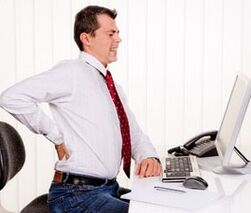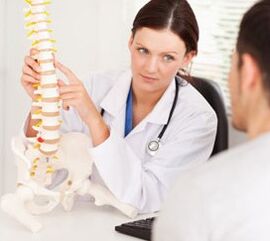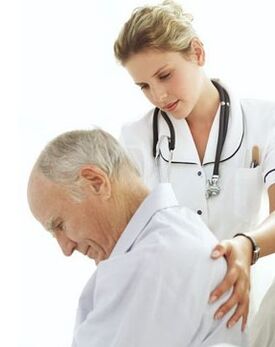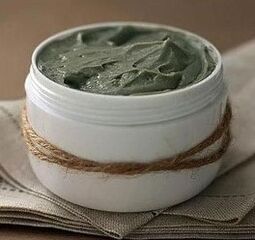Osteochondrosis-The spine disease, a characteristic of which is the degenerative-divophical lesion of the intervertebral discs, and then the vertebral tissues themselves.
The main sign of osteochondrosis is the pain in the neck or back. Among other symptoms, muscle atrophy, altered sensitivity, internal organ work disorders are distinguished. Depending on the location of the pathological process, cervical, thorax and lumbar osteochondrosis are distinguished. If this disease and its treatment do not pay the necessary attention, the process of damage to the spine will be irreversible.

In English literature, the term "osteochondrosis" means a group of diseases of the musculoskeletal system, such as osteochondropathy.
The main factor, or the cause that leads to the development of osteochondrosis, is an unequal distribution of the load in the spine, which occurs when used in a hand or shoulders (for example, bags, backpack), a long stay in a position sitting in the pose, nighttime rests in an unhappy mattress or pillow. Additional factors can also be a sedentary lifestyle, obesity, flat injuries and feet.
All previous situations over the years lead to frequent pain in the cervical, chest or sacral column.
According to statistics, osteochondrosis occurs from 40 to 90% of the world's population, mainly 30 to 35 years. In adverse conditions, this disease develops in adolescence people, which often contributes to the use of a severe uncomfortable backpack, especially in a shoulder, shoes and uncomfortable injuries.
The development of osteochondrosis
The development of osteochondrosis occurs in 4 selected stages (grade):
Osteochondrosis of the first stage.It is characterized by the beginning of the pathological process in the polypozom nucleus of the intervertebral disc: its dehydration (dehydration) occurs, and then decreases the height of the disc. At the same time, cracks begin to appear in the fibrous ring. At this stage, the patient usually does not feel any change. Discomfort can manifest with an unusual position for a person or active exercise.
Osteochondrosis 2 stages.With a decrease in disco height, the distance between neighboring vertebrae also decreases, and vertebrates and ligaments begin to sink slightly. This process leads to the ultravilla of two neighboring rooms, which can lead to their sliding and/or displacement. Spondylolist is formed. Due to the displaced vertebrae, the patient with some load feels real discomfort and sometimes pain in the field of pathology.
Osteochondrosis 3 stages.It is characterized by the formation of prolapses and discs bumps, sometimes subluxation and osteoarthritis occur in intervertebral joints. The patient can feel rigid in some movements, feel tingling in the limbs, sometimes numbness appears. In the third degree of osteochondrosis, pain in the back, neck and coccyx area, depending on the location of the disease, is already present.

Osteochondrosis 4 stages.The body is trying to correct the excessive mobility of the vertebrae, as well as normalize the functioning of the spine. In the place of connection of the vertebrae with pathology, bone neoplasms grow in each of them: osteophytes, which, when forming in an unnecessary place, can cause microtrauma in a nerve column and, sometimes, a neighboring vertebra. On discs and joints, fibrous ankylosis processes can begin. The engine segment is covered and becomes walled. At the same time, the main signs of osteochondrosis are minimized and, sometimes, in general, they are practically not noticed.
Symptoms of osteochondrosis
The main symptoms of osteochondrosis are discomfort and pain in the back or neck. The strength of pain and other related signs of this disease depends on the degree of osteochondrosis.
Of course, due to the pathology of the intervertebral discs, their hernias, the growth in the vertebrae (osteophytes), there are a lot of disorders, such as circulatory disorders, the pinch of the nerves, irritation and violations in the normal functioning of the spinal cord, edema and even the fibrosis of the vertebrae that surrounds the venebras. All these disorders can cause an extensive clinical image of the disease and express themselves by an abundant amount of different symptoms, therefore, without an exhaustive diagnosis of osteochondrosis, it is very difficult to make the correct diagnosis and prescribe adequate treatment.
However, we will consider the main symptoms of osteochondrosis:
- back pain, cervical region, lower back, shoulders and even ribs;
- discomfort, back stiffness with some movements, raising something;
- Numbness of the extremities (arms and/or legs);
- the feeling of pain in arms and legs, chills;
- muscle cramps;
- Genital work disorders;
- Headaches, dizziness;
- heart pain;
- altered sensitivity;
- muscle hypotension;
- Increased fatigue, sometimes the eye.
In addition, depending on the area of the column in which he hit the osteochondrosis, the following symptoms are distinguished:
Osteochondrosis of the cervical column.The pain in the hands and shoulders prevails, headache, dizziness, "flies" or spots in front of the eyes, head noise. These signs can also indicate the presence of vertebral artery syndrome, which can also complicate the work of heart muscle and myocardial blood vessels, if other diseases are present in them.
Osteochondrosis of the thoracic column.The pain in the chest, the areas of the heart and the discomfort in breathing prevail.
Lumbosacra column osteochondrosis.The lower back pain prevails, giving the legs or pelvic organs. Violation of sexual function.

Osteochondrosis complications
If osteochondrosis is not treated and puts in a groove, this can lead to the development of the following diseases and pathologies:
- an intervertebral disc hernia (column hernia);
- outgoing;
- kyphosis;
- Radiculitis;
- deposit in space between the vertebrae of salts;
- spinal cord career;
- lose weight of the limbs and its atrophy;
- Leg paralysis.
The causes of osteochondrosis
- mechanical trauma of the back (spine);
- Physical surgery of the body, hard work;
- nervous exhaustion, stress;
- Metabolism violation, poisoning;
- Frequent stay in places with greater vibration;
- hereditary predisposition;
- sedentary lifestyle, sedentary work;
- violation of the posture at an early age;
- excess weight, obesity;
- flat feet;
- Use uncomfortable shoes (narrow, heels);
- Night vacation in an awkward bed: a mattress, a pillow;
- frequent dehydration;
- inferior nutrition, hypovitaminosis;
- smoking;
- pregnancy.
Osteochondrosis classification
The classification of osteochondrosis is very diverse, because the disease itself has not been completely studied.
We highlight the most popular ways of separating this disease.
Osteochondrosis is distinguished. . .
By location:
- The cervical department ©
- Thoracic region (TH O D)
- Lumbar (L)
- The Sacro Department (S)
Osteochondrosis diagnosis
The diagnosis of osteochondrosis includes the following exam methods:
- anamnesis;
- X -ray exam (x -ry);
- myelography;
- Neurological examination
They can also name:
- Computed tomography (CT);
- Magnetic nuclear resonance (Jamr);
- Magnetic resonance tomography (MRI).
Osteochondrosis treatment
The treatment of osteochondrosis implies the use of a set of measures that must be performed for a fairly long period of time (1-3 months + approximately 1 year to rehabilitation), to which many patients react very ambiguously. Therefore, it should be taken into account that, indirectly, the recommendations of the treating doctor, the prognosis for the recovery of the patient is minimal.

An additional problem in the treatment of osteochondrosis often becomes a car -medication. The fact is that, as is already written in the article, with this disease, the clinical image is quite ambiguous and wide. The patient without a diagnosis begins to select medications against what hurts and, eliminating pain, then deals with his daily life, while the disease continues to progress.
The treatment of osteochondrosis is carried out through two main methods: conservative and surgical treatment. In addition, there are general recommendations in the treatment of osteochondrosis, such as a diet, rehabilitation.
Conservative treatment of osteochondrosis
The conservative treatment of osteochondrosis aims to stop pain syndrome, normalization of the spine and its components, as well as the prevention of new distribution changes in the "axis" of a person.
The conservative treatment of osteochondrosis includes:
Pharmacological therapy.It is used to relieve the pain and inflammation of the components of the spine of the tissues, as well as the normalization of metabolic processes.
To stop pain and inflammation processes, several therapeutic blockages are also used. In addition, they contribute to a decrease in muscle tonic syndrome. Between the therapeutic block there are: trigger points block, as well as intra-honest block, paravertebral and epidural.
Physiotherapy.It is used to relieve pain, improving the effectiveness of pharmacological therapy and in the rehabilitation period. The treatment is carried out using ultrasound, laser, magnetic fields, low frequency currents, etc.
Medical Physical Education (Exercise Therapy), Kines Binhyapy.Especially selected dose exercises aimed at correcting the muscle corset, its strengthening, posture correction, normalization of muscle tissue and its flexibility, decompression of nerve roots, avoiding possible complications of the disease. All of the above is achieved due to the normalization of metabolism and nutrition of intervertebral discs, blood circulation, restores the distance of discs and vertebrae, the distribution of load throughout the musculoskeletal system.
Massage.It is used to improve blood circulation, relieve the rigidity and tension of muscle tissue, improve the general state of health.
Hydromassage.It contributes to the normalization of blood circulation, metabolism, an increase in muscle tone and normalization of the nervous system. It implies a body massage with the help of a stream of water with a certain pressure addressed to it. It is true that the hydromajee has recently prevailed using air bubbles supplied to the body in bathrooms or pools specially equipped.
Manual therapyIt is used according to an individually selected program, which affects the bone muscle system. It helps improve blood circulation and lymphatic cycle, metabolism, mobility of the musculoskeletal system, strengthen the immune system and prevent possible complications.
Extension (traction) of the spine.It is used using special equipment, to increase the intervertebral space, the correction of the structure of the spine, which generally leads to completely minimize or relieve pain.
The integrated use of the previous treatment for osteochondrosis has a good effect.
Osteochondrosis diet
With osteochondrosis, it is necessary to eat 6 times a day, in small portions, drinking at least 1, 5 liters of water a day.
What can be eaten with osteochondrosis:Dairy products, low and fat varieties (chicken, beef), gelatin, flooded fish, gelatin meat, fresh vegetables (tomatoes, cucumbers, onions, carrots, beets, beets, pepper, cabbage, celery, broccolos), fruits, holes, nuts, sun seed seeds, spinach, mushrooms, mushrooms.
What should be minimized in food for osteochondrosis:Grapes, legumes (peas, beans, etc. ), flour products, spicy condiments, sugar, salted foods, meat broths and smoked meats.
It is better to cook food, because with this method of preparation, the products retain the maximum amount of vitamins and trace elements.

Try seasoning salads with olive oil.
Surgical treatment of osteochondrosis
The surgical treatment of osteochondrosis is used if the conservative method is ineffective. Prescribed by the treating doctor. It can also be used for serious spine lesions and its components.
Treatment of osteochondrosis with popular remedies
Popular remedies against osteochondrosis
Mass.Prepare a small dough of rye flour, 300 grams and let it go to bed at room temperature for a couple of days. Drink a glass of milk and rub the place where the back hurts with a treem. After wrapping the dough in a gauze and joining it to the painful stain, tie a cellophane at the top and then a scarf or towel. After a while, you can feel burning and anthilling in that area, but tolerate how much you can. Do the procedure every two days. Use each mass batch no more than 3 times.
Saber.Make a tincture of the saber fish. The place where his back hurts, with the tincture prepared with the tincture prepared and tied her with a handkerchief. In addition, you can take the tincture of the fish saber a few drops before bedtime.
Osteochondrosis ointment.Add 1 tablespoon to the container. A tablespoon of flour, 1 egg, 100 g of butter and 1 tablespoon. A tablespoon of vinegar, mix everything well and place in a dark place for 2 days, to insist. After eliminating the foam resulting from the mixture. Once again, mix the mixture well and rub the resulting ointment in a painful place.
Radish.Mix 300 ml of Rábano juice, 200 g of honey and 100 ml of vodka. Rub your back with the resulting mixture. This popular remedy also helps with radiculitis and rheumatism.



































